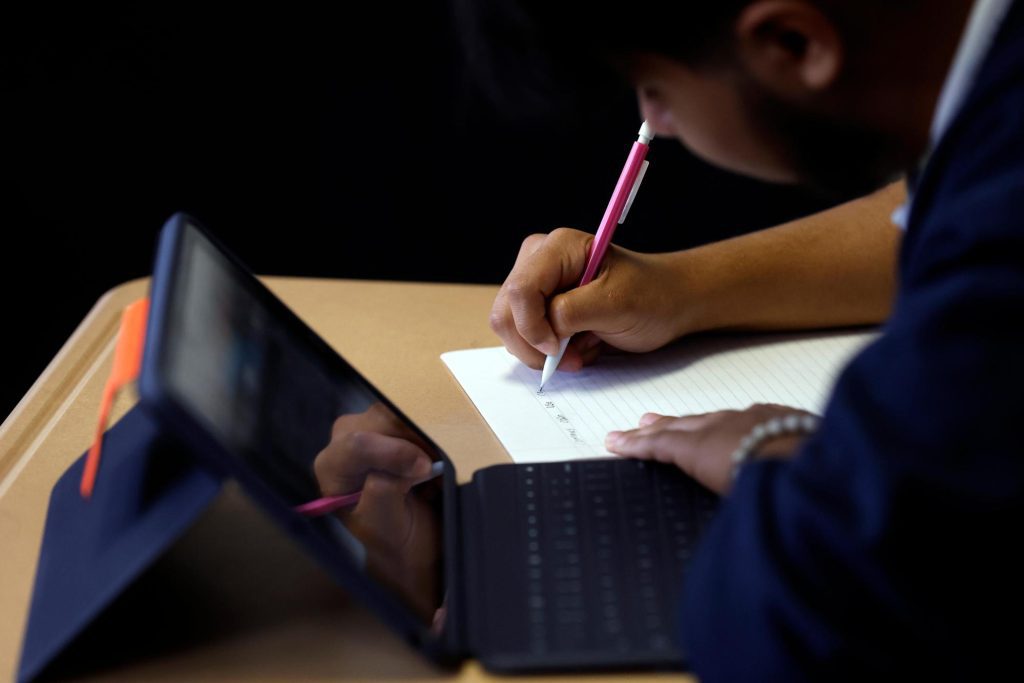By CAROLYN THOMPSON of The Associated Press and REBECCA GRIESBACH of AL.com
BIRMINGHAM, Ala. (AP) — As SAT season starts this weekend, students throughout the U.S. will be using computers and tablets for the first time instead of the traditional pencils that have been used since the test was first introduced almost a century ago.
This is not new to today’s digital natives, but some are still adjusting to the idea.
“I’ve always preferred doing things on paper, so initially I didn’t like it, but it’s not too bad,” said Rachel Morrow, a junior at Holy Family Cristo Rey Catholic High School in Birmingham, where students have been practicing with a digital version. She appreciates a timer feature that helps her stay on track without needing to keep an eye on the clock.
The digital SAT’s launch is happening as its administrator, the College Board, and supporters of standardized tests aim to win over schools and critics who are doubtful about its role in college admissions.
The COVID-19 pandemic resulted in the cancellation of a full SAT testing season and brought increased longstanding doubts about whether the exams favor students from high-income families. Many colleges dropped test requirements, and today most still leave it up to students to decide whether to submit scores.
In recent times, a small number of highly selective colleges such as Dartmouth and Brown announced they would resume requiring SAT or ACT scores. They claim the tests help them identify promising students who might otherwise be overlooked — students from schools that don’t offer advanced coursework and extracurriculars, and whose teachers may be stretched too thin to write glowing letters of recommendation.
Despite colleges not mandating their scores, many students see advantages in taking the SAT.
“Many people are going test-optional now, but if you do provide your scores, you are likely to have an edge,” Morrow said.
Her class has been practicing the digital version of the SAT. The school implemented a mandatory SAT prep course for juniors four years ago in collaboration with CollegeSpring, a nonprofit that offers in-school preparation to assist students from low-income backgrounds in positioning themselves better for college.
The test prep instructor, S’Heelia Marks, mentioned the significance of the SAT for students like hers who are mainly Black and Latino and often from low-income households.
“In America, those are obstacles,” Marks said. “You need to have all the advantages you can to compete. So for colleges, if they’re test-optional and they aren’t familiar with the school you come from or have confidence that those grades aren’t inflated in any way, they will rely on schools they trust, and they are actually excluding people more than you might think.”
The SAT can also open up opportunities for scholarships, but achieving a high enough score often requires rigorous test preparation, which many low-income Americans cannot access.
The electronic exam is one hour shorter and follows the same set up and scoring process. It has two sections – one for math and the other for reading and writing – each worth a maximum of 800 points. The difficulty of the questions adjusts based on the test-takers' performance, becoming slightly easier or harder as they progress. Students can use their own laptops or tablets, but they still need to take the test at a supervised testing site or at school, not at home. To prevent cheating, students are not allowed to use any other program or application while the test is running.
Moving to digital format will not resolve the discussion about fairness. While opponents argue that the SAT and its alternative, the ACT, favor students from higher-income families with more resources, proponents claim that they are still the best predictors of college success and can be considered in the context of socioeconomic factors such as a student's location.
Test administrators assert that the digital SAT addresses what is under their control by including a built-in advanced calculator for use during the exam and by providing free full-length practice exams. They also claim that the results may reveal inequalities in the education system but do not cause them.
Priscilla Rodriguez, who heads the College Board's college readiness assessments division, stated, “Claims about inequalities in standardized testing – which, of course, we pay attention to and care about on a macro level – are reflective of performance differences on tests like the SAT, which mirror the performance gaps seen in every standardized assessment given in the country, dating back to tests administered to third graders.”
According to the College Board, roughly 1.9 million students from the class of 2023 took the SAT at least once, up from 1.7 million in 2022.
Seventeen-year-old Emerson Houser, who is taking the test in Columbus, Ohio, plans to submit her scores to colleges, regardless of whether they are required. Based on her online practice tests, she prefers the digital version.
“We didn’t have to fill in the bubble sheet, so we just had to concentrate on our screens the entire time,” she said. “It made it easier to read the prompts and respond.”
At Holy Family Cristo Rey, junior Ashley Chávez-Cruz mentioned that the digital test has some familiar features, like a highlighting option. However, she pointed out that it's more challenging to mark up problems and passages because you can only make notes in a text box off to the side in the digital version.
But there’s also something less nerve-wracking about taking a test digitally.
“With the paper test, especially because you’re in a quiet room with the clock ticking up there silently, it definitely brings in the sense of an exam,” she said. “With the digital SAT, I still knew it was an exam in my mind, but I was less anxious.” ___
Thompson reported from Buffalo, N.Y. Associated Press journalist Cheyanne Mumphrey in Phoenix contributed.
___
The Associated Press’ education coverage receives financial support from multiple private foundations. AP is solely responsible for all content. Find AP’s standards for working with philanthropies, a list of supporters and funded coverage areas at AP.org.









